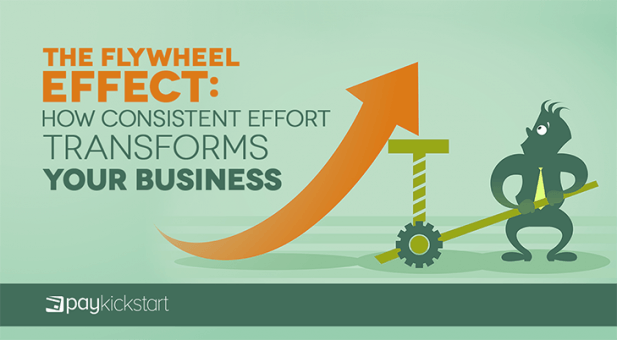Subscription growth hack (by PayKickstart)
Facebook Group - 3,932 members
Visit Group
Subscription businesses are unique. You work hard to get customers through the door but the majority of the value isn’t unlocked until months or even a year down the line.
While you’re waiting, it can feel like nothing is happening. Eventually, as long as you keep going, you gain momentum, a positive feedback loop is created, and everything starts to compound.
This is the flywheel effect in action.
In this article, I’ll dive into what the flywheel effect is, the different aspects, and different ways to apply it.
The flywheel effect isn’t a specific phenomenon but rather a concept. In the book Good to Great by Jim Collins, it’s described as the intermediate processes required to move companies from where they are to world-class.
Put another way, the flywheel effect is the momentum you build and the success you achieve when putting in effort consistently.
Whenever a great company is built, there are countless tiny actions that lead up to the point where it’s recognized as being revolutionary. It’s not a single product, a major feature, or a specific hire that makes it happen.
In the book, Collins describes the flywheel effect as follows:
Picture a huge, heavy flywheel—a massive metal disk mounted horizontally on an axle, about 30 feet in diameter, 2 feet thick, and weighing about 5,000 pounds. Now imagine that your task is to get the flywheel rotating on the axle as fast and long as possible. Pushing with great effort, you get the flywheel to inch forward, moving almost imperceptibly at first. You keep pushing and, after two or three hours of persistent effort, you get the flywheel to complete one entire turn.
Keep pushing, and the flywheel begins to move a bit faster, and with continued great effort, you move it around a second rotation. You keep pushing in a consistent direction. Three turns … four … five … six … the flywheel builds up speed … seven … eight … you keep pushing … nine … ten … it builds momentum … eleven … twelve … moving faster with each turn … twenty … thirty … fifty … a hundred.
Then, at some point—breakthrough! The momentum of the thing kicks in in your favor, hurling the flywheel forward, turn after turn … whoosh! … its own heavy weight working for you. You’re pushing no harder than during the first rotation, but the flywheel goes faster and faster. Each turn of the flywheel builds upon work done earlier, compounding your investment of effort. A thousand times faster, then ten thousand, then a hundred thousand. The huge heavy disk flies forward, with almost unstoppable momentum.
If someone were to show up and ask you which push was the most important, how would you answer? Would you even have an answer?
No, because there’s no single defining moment or action.
There are roughly 4 aspects that come together to create a flywheel effect. If you miss one of them then the flywheel effect won’t exist in your business.
This is the first and most important step. Consistent work toward your goals. Without taking initial action then sustaining that action over time nothing will change or improve.
What most people do is start strong then taper off over time. That’s a mistake. A better strategy would be to start with a level of activity which can be sustained over a longer period of time.
For example, a content marketing strategy requires content. Instead of pushing out 10 articles in one week and going cold for a month, it would be better to create 2 pieces a week for a month. Instead of only testing one marketing strategy, test multiple strategies like implementing a signature for your messages, getting active on forums, and managing a single social platform.
This is a concept that Jeff Olson talks about in The Slight Edge.
The other aspect that has to be taken into consideration is focus. Your actions must be focused in a single direction for the effects to start showing. For this to work, you need a clear plan of action that you execute consistently.
Let’s say you just finished a single rotation of the flywheel in one direction then decided to start turning it in the opposite direction. You’d have to stop the wheel, turn around, and repeat the process.
All the effort you just put in for the first rotation was lost.
This happens more often than not in business. Entrepreneurs start a new marketing initiative, don’t get instant results, and start off on a new path. The same can be said for business ideas. Many people start a business and quit before the momentum kicks in. They then start a new business and repeat the cycle.
This is where it starts to get interesting. Before momentum starts, you’ve probably been at it for a while. You’ve got your marketing, business, or product off the ground and it’s starting to move faster and faster.
Subscription businesses feel this the most with MRR growth. As long as you continue to apply incremental inputs, the momentum will increase.
This is an eventuality of the other three aspects. Each one of your small actions adds up. Eventually, it doesn’t add up anymore, it starts to multiply itself.
At first, it’s a multiple of 1.2 then 1.3 then 1.5 and so on and so forth. Soon, the smallest inputs have outlandish results. This can be a double-edged sword – especially with social media.
When you have an established reputation, anything you put out into the world will be noticed. That can lead to huge public successes and huge public failures.
Snapchat allowed a tasteless ad on its platform which cost it hundreds of millions of dollars.

I’d like to note that the flywheel effect is what happens when you exploit a competitive advantage you have or create. It alone is not a competitive advantage.
Here are a few applications to illustrate how the flywheel effect kicks in and continues to solidify your lead.
Think about mega-organizations like Google and Standard Oil. Google is huge and uses the revenue from being huge to further solidify its lead in the marketplace. It’s been able to avoid monopoly accusations because it has framed its business as one technology company in a multi-trillion dollar market.
Standard Oil got huge and was able to manufacture products cheaper than the competition. They were able to sell cheaper and negotiate better deals with railroads to capture even more market share. Over time, no one was able to compete.
If everyone else is buying from them then they must be doing something right. Companies with a strong brand can command mindshare. When people are ready to purchase a solution they consider multiple companies.
If they have no previous experience, they look to the crowd. The service other people are using and endorsing will most likely get the sale.
The more they close deals, the easier it is to close the next one because there are more people talking about it.
These are most commonly seen with social media apps and certain business tools focused around team communication and collaboration.
In order to derive value from team communication software, you need people to chat with. Otherwise, it’s a poor note-taking app. When someone signs up for a new team communication tool like Slack or Chatter, they invite a few colleagues. If the pilot group derives value, they add their entire organization as soon as possible.
That organization may also bring on contractors they work with. Those contractors like the tool and bring it to their clients and so on and so forth.
The same process applies to social media. You only derive value when there are people to share and interact with so you invite your friends.
In both of these situations, the network effects take on a life of their own. This is more powerful than a standard flywheel effect. It’s like the flywheel effect on steroids.
Content marketing is getting more and more popular by the day. That presents an opportunity and a challenge. You can reach your audience but competitors are also vying for the same attention.
If you host a podcast, create regular content for your blog, or make videos for YouTube you may be aware of the uphill battle.
If you’re able to deliver high-quality content consistently then you’ll start to see the effects of it. First, a few people will discover you organically. Then a few more. After a while, even more people will start tuning in for your podcast episodes or videos.
Before you know what’s happening, other companies will be knocking at your door for a comarketing partnership and other benefits. This doesn’t happen until you put in the effort in the beginning.
On a side note, content creation doesn’t help you unless you’re also promoting the content regularly. After you hit critical mass, it’ll start growing on its own. You know, the flywheel effect.
The flywheel effect is a powerful concept that kicks in after you’ve put in a considerable amount of work. It doesn’t happen overnight and the initial stages can be hard.
As long as you keep going then you’ll eventually hit all of your targets and then some.
The key to unleashing the flywheel effect is to apply consistent effort in a single direction. That’s when momentum and compounding results start to take effect.
Let me know what you think of the flywheel effect in the comments and don’t forget to share.
Daniel Ndukwu is a regular contributor to the PayKickstart blog. He has extensive experience with online businesses, conversion optimization, and subscription revenue models. When he's not writing insightful content, he works with other entrepreneurs to help them grow their bottom line.
Read More About Daniel Ndukwu